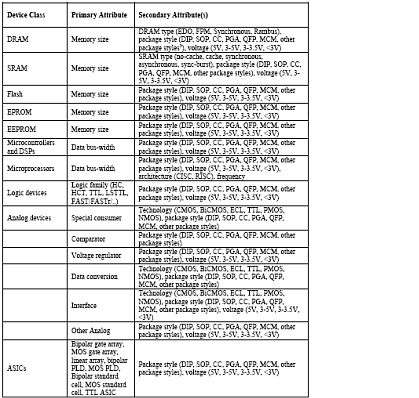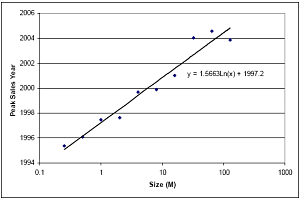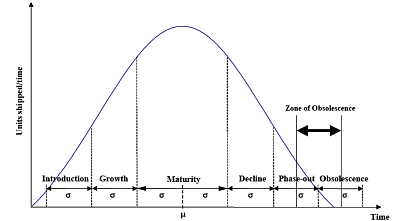Chapter 5 - the problem of the forecast of rebelling of the obsolescence.
The traditional method for the forecast of the cycle of life of the electronic members, is based on an approach score-card, in which the phase of the life, in which a device is found, is determined through an Array of technological attributes: to every attribute they are conferred a code, relative to the cycle of life, comprised between and a six (in agreement with is made characterized from Pecht and Das: one for the introductory phase and six for the phase of dismissione and obsolescence), and a weight.
The phase in which the device is found determines making one medium weighed of the relative codes you the cycle of life of the attributes.
The defect of this method is the fact that it does not consider the effective courses of the market, in how much it is based on not quantifiable technological attributes like the technological complexity and on ephemeral attributes of market as the use.
Moreover I found its roots in the erroneous assumption that all IC (the Integrated Circuit) follow the same cycle of life and that all it is made of this have the same length.
An other approach I found myself on a “factor of reliability” that serves in order to characterize a “temporal window of emergency” in which the member can be used calmly.
This method uses technological factors and of market of dispositi to you similar to those for which the obsolescence forecast is necessary; it does not take in consideration, therefore, the life cycle neither allows to characterize the phase of it in which the member finds itself.
At last, a forecast method that complyd with the deficiencies described for the approaches to the forecast pregressi, was proposed from Sanborn, Solomon and Pecht in 2000: this new one modus operandi allows to design the bell-shaped curve, basing the forecast on sale data passes to you and characteristic own of the member. The steps to follow in order to obtain the intentional information are:

Figure 5.4: Logical flow to the base of the previsional model of Sandborn, Salomon and Pecht.
In the detail, they are therefore develops to you:
- Identification of the technological class to which the device belongs: A technological class is with of devices that share technical characteristics and work them, but that they can be produced from various enterprises.
- Location of the primary attribute and those secondary ones: the first one is one characteristic that defines a technological class, while the second ones are attributes that can modify the phase of the life cycle and therefore the moment of the obsolescence of one technological class. An example of technological classes and of you respect primary attributes to you and secondary it comes brought back in the following table.

Table 5.1: Examples of technological classes with relati primary attributes to you and secondary6.
- Determination of the number of sources for the device under investigation; if he does not succeed himself to identify some industry manufacturer, the member is already obsolete.
- Collection of the regarding data of sale the primary attribute of the technological class. If a technological class comprises dispositi to you characterizes to you from more values for the primary attribute, therefore, the trend will have to be searched of sale for everyone of they. If one has been interested to a device in particular, will be enough to collezionare the relative data of sale to its value of primary attribute. An example of what it will be able to be obtained with the search is shown in the following figure, in which the data of sale for a flash are brought back memory whose primary attribute is the dimension measured in megabit (M) 7.

Figure 5.5: Data of sale for a flash memory, relati to you to the various values that the primary attribute of the class (dimension of the memory) assumes.
The collection of the relative data of sale you to all the values that the primary attribute assumes, that identifies several the devices you pertaining to a class, is useful when it has been interested to the forecast of the cycle of life of devices you, pertaining to the same class, but with value of different primary attribute from those for which news is had: from the trend it finds to you, in fact, extrapolate the year of the sale peaks and the shunting lines are estimated standard, through the calculation of the standard deviation, if it is obtained in the following way:

n = Number of observations, that is number of data available;
xi = given Value of the i-esimo;
= Medium collection of samples;
Devout = = Relative frequency of i-esima the observation.
Through these data, making reference to statistics in Fig. 5,5, diagrams of the type in Fig. 5,6 and 5,7 can be obtained according to, from which, through extrapolation, they are succeeded to find the mathematical expressions of the average and the shunting line standard, the primary attribute of the class.

Figure 5.6: Trend of the years in which the peaks of sale for the flash are had memory8.

Figure 5.6: Trend of the years in which the peaks of sale for the flash are had memory8.
This approach can be used also for dispositi to you that they are not still in commerce, but for which it knows the class of belongings and the value that the primary attribute will assume.
- Construction of the representative curve of the cycle of life of the device pertaining to the technological class in issue and identified from the primary attribute for which one has been interested to the forecast. The profile of the curve is modeled a Gaussian one second that follows the equation:

The curve is the graphical rappresentazione of the units sold in the time, the average µ of the curve is the temporal moment (year) in which the peak in the sold amounts has been taken place, the parameter k is the peak of sale measured in sold units; if such value is the percentage of the sold units, the function describes the course of the percentage of sale in the time. Variable the x and the time in years.
- Determination of the zone of obsolescence based on the primary attribute: when this method came published in 2000, the obsolescence zone was defined like:

The factor p is the running date in which the forecast is made.
The result will be one curve of the type in figure.

Figure 5.8: Representative curve of the cycle of life of a device, identified from average µ and shunting line standard9.
It is made of the life cycle are defined in the following way:
- Introduction =;
- Increase =;
- Maturity =;
- Decline =;
- Phase-out =.
- Modification of the zone of obsolescence based on the secondary attributes. The same forecast is developed for every secondary attribute; if the year in which one of these last ones begins the obsolescence zone in order at least falls that is within the vital window of the relative cycle of life to the primary attribute (in), then, the zone of obsolescence characterized for the generic device it must be modified. In the following table the algorithm is reassumed in order to carry out such modification.

Table 5.2: Algorithm in order to modify the zone of obsolescence based on the secondary attributes of the technological class.
In the Tab.5.2, with j the secondary attribute has been indicated j-esimo, with µj the average relative to its cycle of life and with sj, the shunting line relative standard to it. In a recent one article 10, Sandborn, Mauro and Knox, have proposed one modification to this type of forecast of the obsolescence window: they suggest that the specification of the obsolescence window depends on the rules of business of the specific supplier and the specific part.
The logical distance to follow in this rivisitata version of the forecast method is following: for every device, the relative data you to the date of the last ordinazione are record to you and classify to you from the producer.
Every request of the part, in the classification of the data, has a value of the primary attribute, for which the parameters µp and sp with the described method can be gained over; the last date of ordinazione of the request of the part, per year comes hour standardized in relation of the sale peak µp.
Such procedure comes repeated for every request of the part, for which the analysis of the obsolescence is being lead, ordered and for every supplier.
The successive step is that one to reassume such give standardized in a histogram, from which it will be, then, extrapolated a Gaussian one and you respect parameters to you µlo and slo.
The obsolescence window is supplied, second asserted how much from the article, the expression:

Where x indicate the wished level of confidanza:
x=1 a level of confidenza of 68% concurs;
x=2 a level of equal confidenza concurs with 95%.
A use of succeeding of the tool present on the market for the forecast of the obsolescences, I found its validity on the assumption that such forecast often is brought up-to-date; moreover, it becomes taken care of more, as approaches itself to us the given effective of obsolescence. This implies, that the value of the forecasts, depends, in great part, from the ability of the organization to institute a continuous monitoring of the market and, he turns out to you obtainable from such information, make confidence in the bravura to face, in fast way, rebelling of an obsolescence problem. Ill-fatedly, the more it is approached to us the moment in which such problems they will rebel, less effective will be to have some foretold the date: this, in fact, renders spaces, or little useful, the efforts prosthesis to put in actions participations estimates in order to contrast the phenomenon obsolescence.
The method of forecast, described in the previous pages, comes introduced, from the author of articles on it centralizes to you, like a step towards the availability of one effectively efficient forecast, supported from quantifiable limits of confidenza.
- 5: R. Solomon, P. Sandborn, M. Pecht, Electronic part life cycle concepts and obsolescence forecasting, IEE Transactions on Components and Packaging Technologies, vol. 23, n° 4, December 2000.
- 6: R. Solomon, P. Sandborn, M. Pecht, Electronic part life cycle concepts and obsolescence forecasting, IEE Transactions on Components and Packaging Technologies, vol. 23, n° 4, December 2000.
- 7: P. Sandborn, F. Mauro, R. Knox, To date mining based approach to electronic part obsolescence forecasting, Actions from the conference on DMSMS 2005.
- 8: P. Sandborn, F. Mauro, R. Knox, To date mining based approach to electronic part obsolescence forecasting, Actions from the conference on DMSMS 2005.
- 9: R. Solomon, P. Sandborn, M. Pecht, Electronic part life cycle concepts and obsolescence forecasting, IEE Transactions on Components and Packaging Technologies, vol. 23, n° 4, December 2000.
- 10: P. Sandborn, F. Mauro, R. Knox, A data mining based approach to electronic part obsolescence forecasting, Atti dalla conferenza sul DMSMS 2005.








